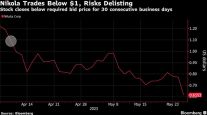Trucking Stocks Soar in 2014, Beat Major Market Indexes
This story appears in the July 7 print edition of Transport Topics.
Trucking stock prices this year have soared past the broader stock market that is hovering around record levels, propelled by tight capacity and improving freight-industry expectations.
As a group, asset-based trucking stocks increased 20% in the first half of 2014, according to Bloomberg Industries, nearly triple the 7.2% increase in the Standard & Poor’s 500. Also, a Transport Topics review found share prices for 17 of 22 asset-based trucking companies are at or near record levels.
Other comparisons also were favorable.
In the first half, asset-based truckers widely outperformed the Dow Jones industrials, which increased 2.3%, and the Nasdaq index, which climbed 6.5% in the first half. On a year-over-year basis, asset-based carriers’ shares on average rose 55%.
“People are much more bullish on the outlook for trucking stocks with the backdrop of an improving economy,” said Jason Seidl, a Cowen and Co. analyst, citing chronically tight capacity and rising rates.
Trucking stocks are doing better than the market as a whole because of their greater sensitivity to changes in the economy, Seidl said.
Privately held carriers, whose results aren’t publicly disclosed, also are benefiting, Seidl said, noting “this [improved business] is good for everybody.”
Industry indicators such as American Trucking Associations’ tonnage index and load reports are pointing in a positive direction. In addition, the U.S. economy is growing; it is due to hit 2.2% this year and further improve to 3% next year, based on a Bloomberg survey of analysts.
Stifel. Nicolaus & Co. analyst John Larkin had another perspective.
“For the fourth consecutive year, many investors continued to come out of the chute at the beginning of the year believing that this will be the year that the economy breaks out of the slow-growth recovery mode,” Larkin said.
Factors such as a worsening driver shortage, capacity reductions tied to the driver shortage, regulatory restrictions and preshipping in advance of the June 30 West Coast labor contract expiration boosted trucking, Larkin said in a July 1 interview with TT.
Share prices of the 13 publicly traded truckload companies improved overall stock performance by 18%. Of the 13 operators, 11 showed higher share prices. Only J.B. Hunt Transport Services, No. 4 on the Transport Topics Top 100 list of the largest for-hire carriers in the United States and Canada, and No. 26 Universal Truckload Services saw declines — 4% and 17%, respectively.
Covenant Transportation Group, No. 41, whose profitability usually trails competitors, was the largest gainer of any publicly traded stock. Its shares leaped 62% in the first half.
USA Truck, No. 52, another truckload company whose profitability usually lags — although recent operational and financial performance has improved — posted the second-largest increase at 48%.
Despite severe weather that hurt first-quarter operating ratios, expectations are rising in the truckload sector because of lower empty-mile ratios and higher rates excluding fuel surcharge, Bloomberg Industries analyst Lee Klaskow said.
“These trends should translate into improved margins, assuming carriers are able to manage rising cost of attracting and retaining drivers,” Klaskow noted.
The gains were even stronger in the less-than-truckload sector, where shares gained an average of 29% in the first half. The largest gainers were No. 22 Saia Inc. at 44% and No. 5 YRC Worldwide at 43%. All six public LTL operators’ shares rose.
“LTL carriers are benefiting from the operating leverage from increased freight through their asset-intensive networks and rational pricing,” Klaskow said.
Truck leasing also proved popular with investors as Ryder System’s stock price improved 21%, reflecting the sector’s improved business.
Stock price trends were less favorable in the package sector where No. 1 UPS Inc. shares dipped 1% and No. 2 FedEx Corp. climbed 8%.
In the logistics sector, share prices showed no change overall.
Investors embraced Hub Group — No. 29 on the Transport Topics Logistics 50 and No. 2 on the intermodal/drayage sector list in the for-hire TT100 — pushing shares up 28% for the intermodal-focused business, which is on record pace this year, while No. 26 UTi Worldwide shares have tumbled 41% this year. The other price drop was at Echo Global Logistics, No. 5 on the sector list of the Top 25 Freight Brokerage Firms.
Analysts had varying views about the second half.
“It will be interesting to see if this share price momentum continues into the second half of the year, given that so many of the positive first-half factors won’t be there in the second,” Larkin said.
He also said he wasn’t sure that second-half capacity shortages would lead to large rate increases because most carriers’ rates are tied to contracts.
Seidl was more optimistic, stating that “people are starting to realize that the capacity issues we have are not going to be resolved soon. We have a period of rising pricing power for the carriers. The economic backdrop is very solid — the U.S. is a pretty good place to be right now.”
Klaskow said markets are proxy for investor expectations six to 12 months ahead, noting that trucking shares began outpacing the market a year ago.
Share prices haven’t been affected so far this year by fuel prices, which have been holding steady, Seidl said, providing a change from past years when fuel became increasingly burdensome.


